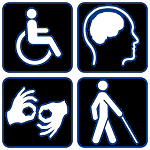
Students:
The Office of Disability Services is designated to assist all students with disabilities and is available to discuss emergency procedures with students and familiarize them with evacuation routes specific to their housing and classroom assignments. For more information please contact the office at 305-284-2374 (TDD 305-284-3401) or visit their website at www.umarc.miami.edu.
Faculty and Staff:
The Workplace Equity and Performance office can assist faculty and staff with disabilities. In addition, University faculty, staff, and students with ADA (Americans with Disabilities Act) related questions, concerns, and grievances should contact Workplace Equity and Performance. For more information, please visit their website at www.miami.edu/wep.
It is imperative that individuals with physical disabilities prepare for emergencies before they happen. Please review the action guidelines below and contact the Office of Emergency Management at (305) 284-8005 or oem@miami.edu for more information.
Coral Gables Map w/ Accessibility Details
Action Guidelines
For assisting individuals with disabilities:
• Check on people with disabilities during an emergency.
• Ask if someone needs help, how you can properly provide assistance, and if any items need to accompany them.
• Do not use elevators for emergency evacuation.
For Assisting in Evacuation by Disability Type
Mobility Impairment:
• If a person cannot exit the building, ask if assistance is needed.
• If they elect to await evacuation assistance, escort the person to the nearest stairwell or other predetermined area of refuge.
• Some individuals with mobility impairments who are able to walk independently may be able to negotiate stairs with minor assistance.
• Do not try to carry anyone with a mobility impairment. You could do more harm to them or yourself.
• After you leave the building, immediately inform emergency responders of the location of the person awaiting evacuation.
Blindness or Visual Impairment:
• Give verbal instructions about the safest route or direction using directional terms and estimated distances.
• Ask if assistance is needed, if so, offer your elbow and provide guidance through the evacuation route. This may be especially helpful if there is debris or a crowd. (Never grasp the arm of the person you are assisting).
• While escorting a person out of the building, explain as you are walking where you are going and what you are doing.
Deafness, Hearing Loss, Language Difficulty:
• Get their attention by eye contact or touch, if necessary.
• Communicate the problem including the need to evacuate. Gesturing and pointing are helpful, but be prepared to write a brief statement if the person does not seem to understand.
• Offer visual instructions to designate the safest route or direction by pointing toward exits or evacuation maps.
• Offer to escort them from the building.




